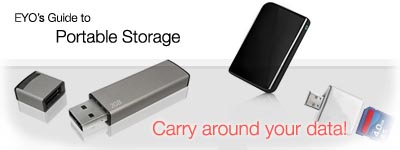EYO Feature Article: EYO’s Guide to Portable Storage
(The copyrights© of all EYO Feature Articles are the property of Eyo Technologies Pty Ltd. Reproducing without permission is prohibited.)

EYO’s Guide to Portable Storage
EYO’s Guide to Portable Storage
Everyone’s on the go these days, and it seems that everyone has important personal data to carry around as well. What’s the best way of protecting that information? How do you strike the balance between convenience, performance and price? And how do you make sense of the massive array of storage options?
You can break portable storage down into four main groups:
1. Low-capacity media cards
2. Medium-capacity flash drives
3. High-capacity 2.5” external hard drives
4. Very high-capacity 3.5” external hard drives
Media Cards
Media cards are storage devices originally designed to fit devices which had a need for high-speed, small form factor storage like digital cameras. Originally, media cards had a very low storage capacity (around 16MB), but now most cards range of 128MB to 1GB, with 2GB and 4GB options available in some standards, like SanDIsk CompactFlash.
For media cards to be accessible, you need a card reader of some description. Most computers these days, especially notebooks, have multi-format card readers pre-installed, but you can easily buy a USB reader, capable of reading all popular formats. However, this reliance on an available reader is a limitation on using media cards as personal portable storage.
Flash Drives
Flash drives are also known as USB sticks or USB keys. Like media cards, they are a solid-state storage device (ie: no moving parts), but they are interfaced to a USB connector. This allows you to connect them to any machine with an operating system and a USB port (which is pretty much every computer).
The beauty of USB sticks is that they’re small enough to be attached to a key ring, but being solid-state they’re also pretty robust. The drivers needed to access them are also common across all operating systems – Windows, Linux and Mac OS – so you’re always confident of it working.
USB sticks now also come with pretty good capacity – 1GB and 2GB are common, but you can pick up anywhere from 4GB to 16GB devices, which is more than enough for most people’s requirements. The only proviso is that although you can buy units with good capacity at a low price, consider purchasing a unit with lower-capacity but of a high quality. Although they’re USB 2.0 devices, slow flash memory can make copying files to and from the device a painfully time-wasting experience.
2.5” External HDD & 3.5” External HDD
External hard drives are the way to go if you need lots of storage. You’re only really limited by the availability of drives on the market and how much you’re prepared to spend.
There’s one main decision to make when purchasing an external drive – whether you want an enclosure with a drive you can install yourself, or a pre-fitted unit. The pre-fitted units tend to be more expensive, but the enclosures and power connectors tend to be of a very good quality. External drives have moving parts, so protecting the drive itself can be paramount, especially if you’re carting it around a lot.
Enclosures without hard drives vary wildly in terms of quality. Most enclosures offer a USB 2.0 and/or IEE1394 (firewire) adaptor which connects to the internal SATA or IDE hard drive. Some enclosures have only USB ports, while others have both. Some more expensive units have eSATA or FireWire800 ports for faster data transfer.
Power is a consideration with external units. 2.5” hard drive enclosures don’t always need a secondary power source, as they can draw their power from the USB port. However if the system’s USB hub is already powering other devices, you might experience random drop-outs. This can corrupt live data and even damage the on-disk partition. You can buy 2.5” enclosures which have a secondary USB cable for power. These are less convenient, but far more reliable.
3.5” enclosures always require power from the mains. They also hold desktop hard drives which means that they offer far more storage.
The best rule of thumb when buying portable storage is to think about how much you really need, and how protected you want that data to be. Of course, any device can fail and you should always back up your data, but it’s still worthwhile spending a bit extra for a robust unit.
EYO Technologies is asking you our valued customers to submit a technology or product related topic you would like us to write about and publish in our website. If you'd like to see a particular topic feature on any trends, technological advancement in computers or just want to learn more about a product then do let us know! Our friendly staff will look into your suggestion and if we think it would be useful we will write about it to be published on our homepage.
Simply email your suggested topic to: marketing@eyo.com.au
Check out the past articles we have explored for our customers:
EYO Feature Article: Control Freaks: The 101 on Gaming Accessories
EYO Feature Article: Fully Loaded: EYO's Guide to PC Storage
EYO Feature Article: Size Matters: EYO's Guide to LCD Monitors
EYO Feature Article: Networking: EYO's Guide to Networking for the Home
EYO Feature Article: Networking: EYO's Guide to Office Networking
EYO Feature Article: 7 Facts about Windows Vista Storage Requirements
EYO Feature Article: Vista Hardware Requirements
EYO Feature Article: EYO’s Guide to Mobile Computer and Notebook Technology
EYO Feature Article: EYO’s Guide to Bluetooth Technology
EYO Feature Article: EYO’s Guide to WiFi

 Kingston Tool
Kingston Tool

